[Ebook] Indoor Gardening Houseplants 2016 USA Magazine 2016 USA, Indoor Gardening Houseplants Magazine
[Ebook] Indoor Gardening Houseplants 2016 USA Magazine – VII – Gardens Under Glass (Vườn thuỷ tinh)
- Dịch: Huyền Nguyễn
ENGLISH
INSIDE A SHELTER OF SPARKLING GLASS, PLANTS GET THE BOOST THEY NEED TO THRIVE INDOORS, AND YOU GET A BIRD’S-EYE VIEW OF THE ACTION.
- PHOTOGRAPHERS: HELEN NORMAN, MICHAEL PARTENIO, STEVEN RENDAZZO, ANDGREG SCHEIDEMANN
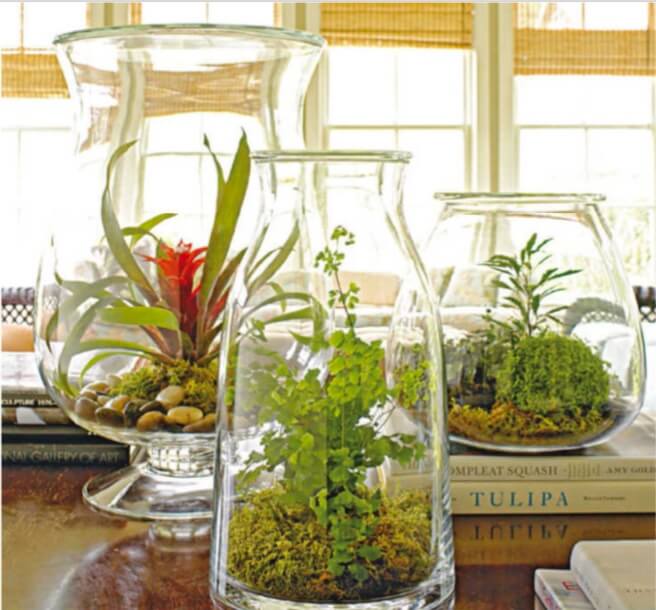
Terrariums
A terrarium defies many of the typical challenges of gardening. The miniature garden encased in glass rarely sprouts a weed. The need for supplemental watering is reduced by condensation forming water droplets that dribble back down to the soil and recycle moisture. The portable container allows you to move the garden into bright-but-indirect light in one room or another.
Magic under glass
A terrarium can be full of surprises, holding a collection of small, compatible plants that like low light and high humidity, lichen-covered branches, or exquisite orchids. Children are drawn to terrariums as miniature worlds where they can learn about gardening with a few plants in an old aquarium or a goldfish bowl. The most easy-care terrariums hold potted plants, making it a breeze to change the display whenever you want.
The container you choose helps give a terrarium its appeal, from the sparkle of a giant clear-glass globe to the shapely charm of a lidded apothecary jar. A terrarium that’s open at the top allows air to flow freely; an enclosed terrarium needs just a little watering and regular opening to allow ventilation. Scour crafts stores, flea markets, and garage sales for containers, whether you prefer an oversize brandy snifter or a pickle jar. Choose a vessel you can fit your hand into to ease planting and maintenance. Always start with a clean container.
Planting a terrarium
Your terrarium might include a few carnivorous plants or dwarf and slow-growing houseplants that will appreciate the low light and high humidity inside it. Plants with bold-color foliage are easiest to see inside the glass and contrast with other plants. Start with various-size plants for a grouping. Succulents, cacti, and other plants that like dry conditions rot rapidly in a closed or moist terrarium, so plant them in an open glass container and sterile sand layered with pebbles instead.
Make an ideal potting mix for a terrarium by blending two parts peat-based potting mix, one part sterile sand, and one part perlite or vermiculite. After planting, top the soil mix with moss, gravel, or sand for a decorative effect.
Keep it growing
Lightly dampen the soil after planting, sprinkling water until it drips into the pebbles. Water an open terrarium when the soil appears dry—every 7 to 10 days. A closed terrarium needs watering every two weeks or less. Periodically wipe the glass inside and out with a clean cloth.
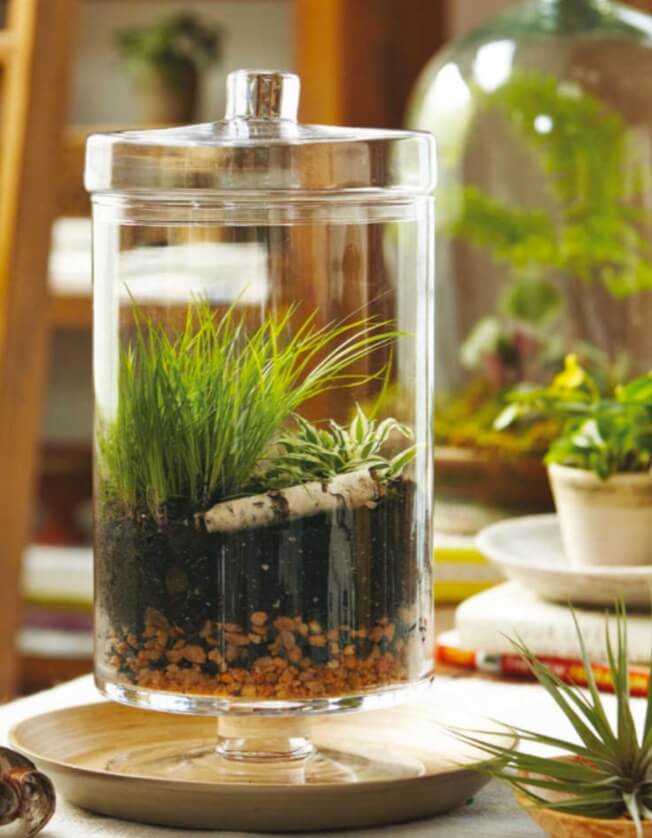
How to Make a Terrarium
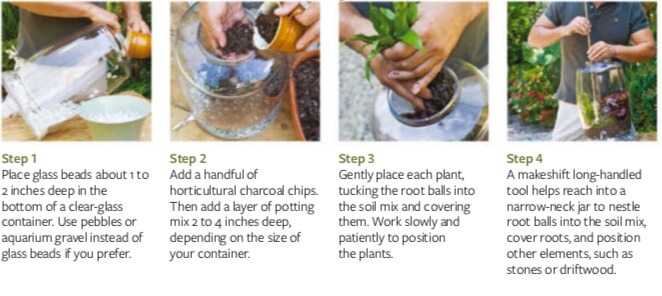
Step 1
- Place glass beads about 1 to 2 inches deep in the bottom of a clear-glass container. Use pebbles or aquarium gravel instead of glass beads if you prefer.
Step 2
- Add a handful of horticultural charcoal chips. Then add a layer of potting mix 2 to 4 inches deep, depending on the size of your container.
Step 3
- Gently place each plant, tucking the root balls into the soil mix and covering them. Work slowly and patiently to position the plants.
Step 4
- A makeshift long-handled tool helps reach into a narrow-neck jar to nestle root balls into the soil mix, cover roots, and position other elements, such as stones or driftwood.
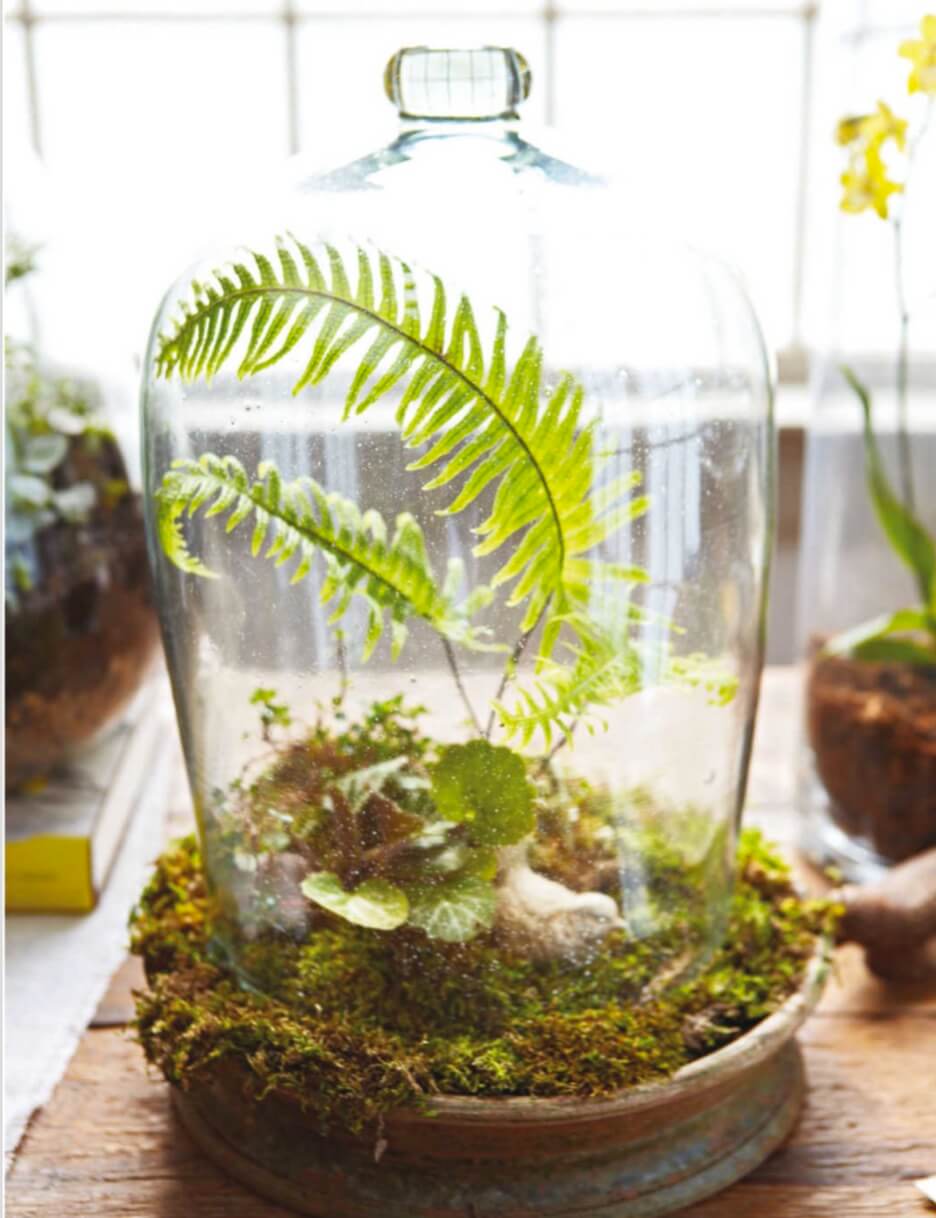
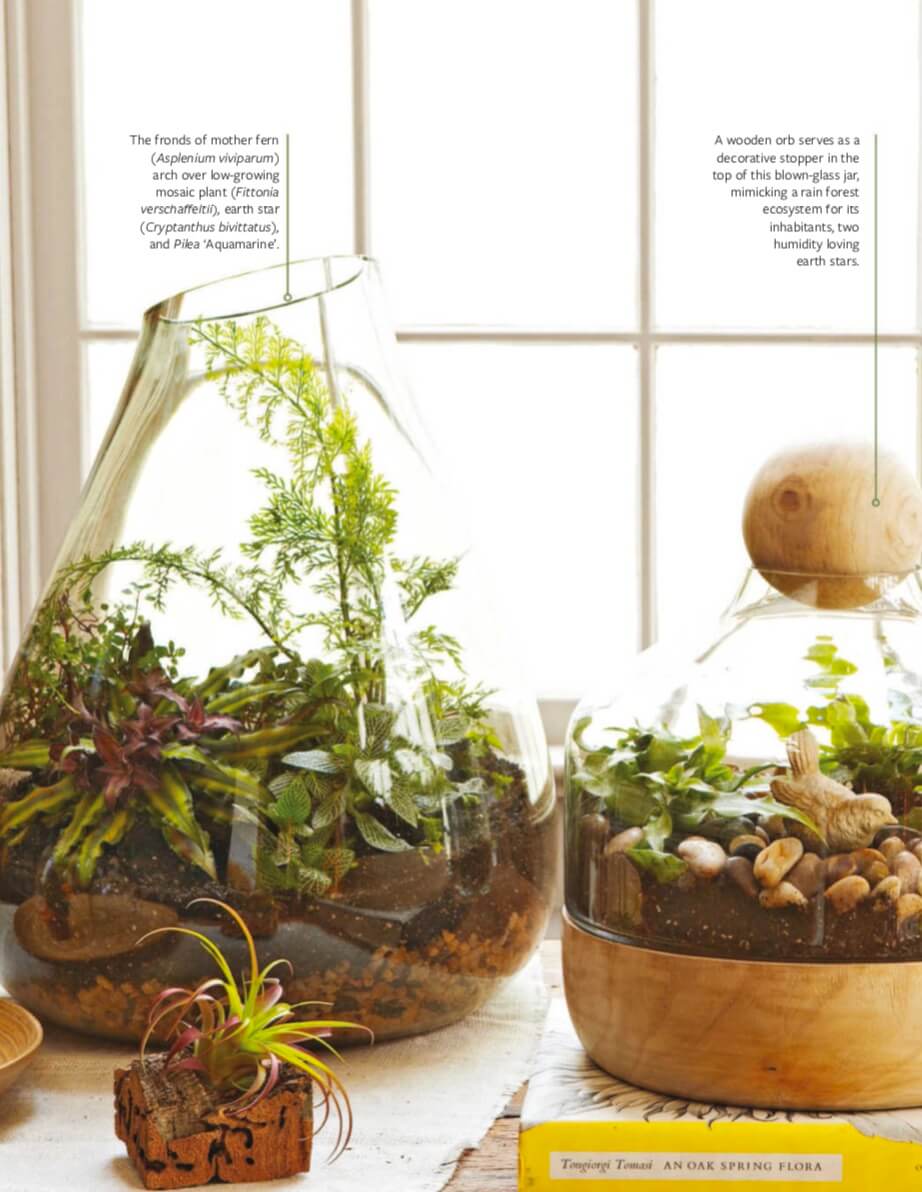
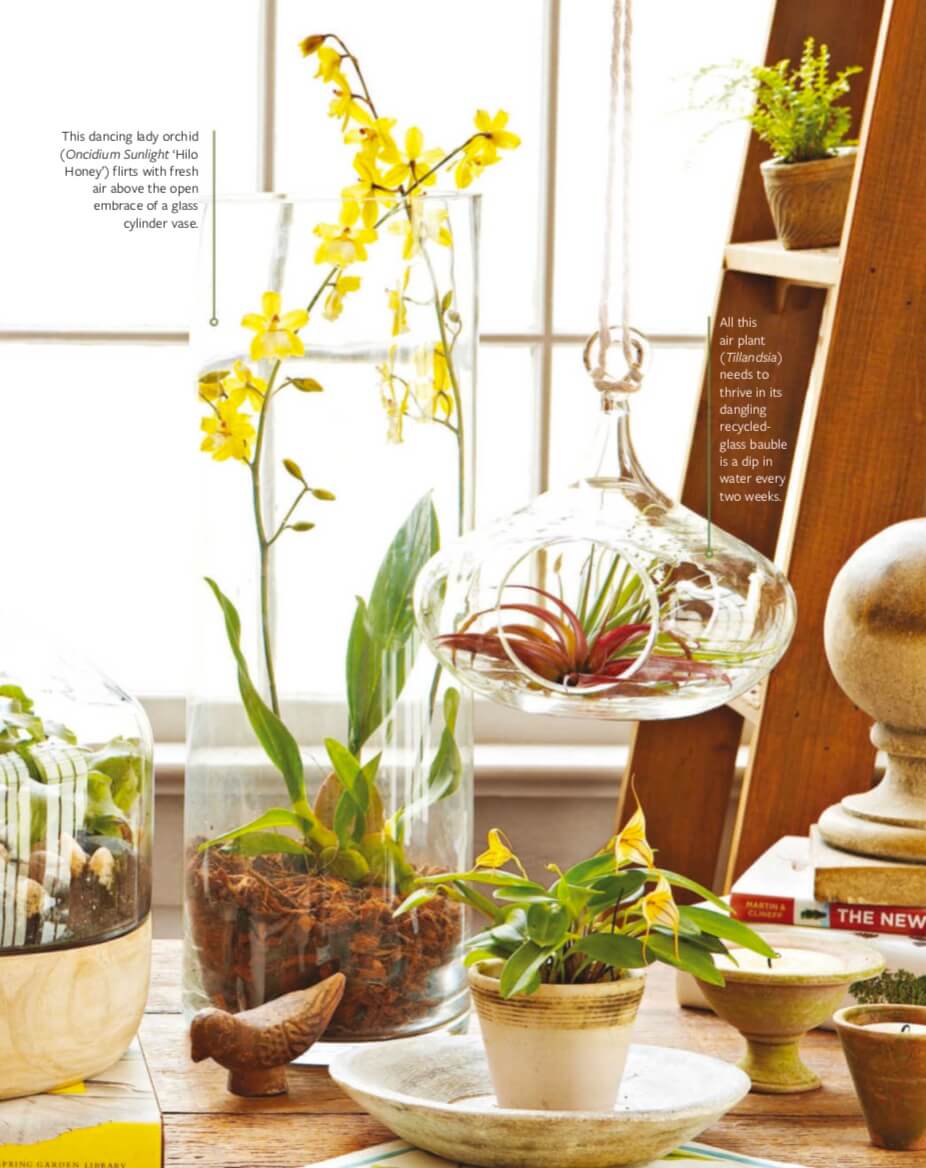
Tabletop Conservatories
Miniature conservatories, also known as Wardian cases, have been favorites of gardeners since Victorian times. The fanciful glass enclosures are downsized versions of the elegant greenhouses and conservatories often photographed in English gardens. The full-size glass and metal or wood structures remain fantasies for most gardeners. But miniature conservatories offer a reasonable alternative for those with fewer resources. All it takes to make one of these gardens under glass is a conservatory and a few humidity loving plants, such as fern, dracena, and polka-dot plant.
The Wardian case
These charming enclosures for indoor gardens were developed in the early 1800s by a London doctor, Nathaniel Ward, who wanted to watch a sphinx moth chrysalis develop in a closed jar. The man was so enthralled with his project’s success, he began growing plants of all sorts in glass enclosures. Before long, the plant hunters of that time, roaming the planet in search of exotic new treasures, depended on Wardian cases as a way to transport their finds with minimal watering and attention.
Today, miniature conservatories have staged a comeback with the resurgence of indoor gardening and the renewed popularity of terrariums. A stylish conservatory becomes a beautiful tabletop garden when filled with small, seasonally blooming annuals or bulbs. It’s also an ideal nursery for young plants, especially ferns and others that thrive in the humid environment created by the structure.
Many miniature conservatories are so architecturally captivating, they’re used as a handsome backdrop for a few plants or other decorative objects. Some conservatories come with a built-in tray. If it doesn’t, you can plant in a deep- enough tray or set potted plants on a tray and cover them with the conservatory.
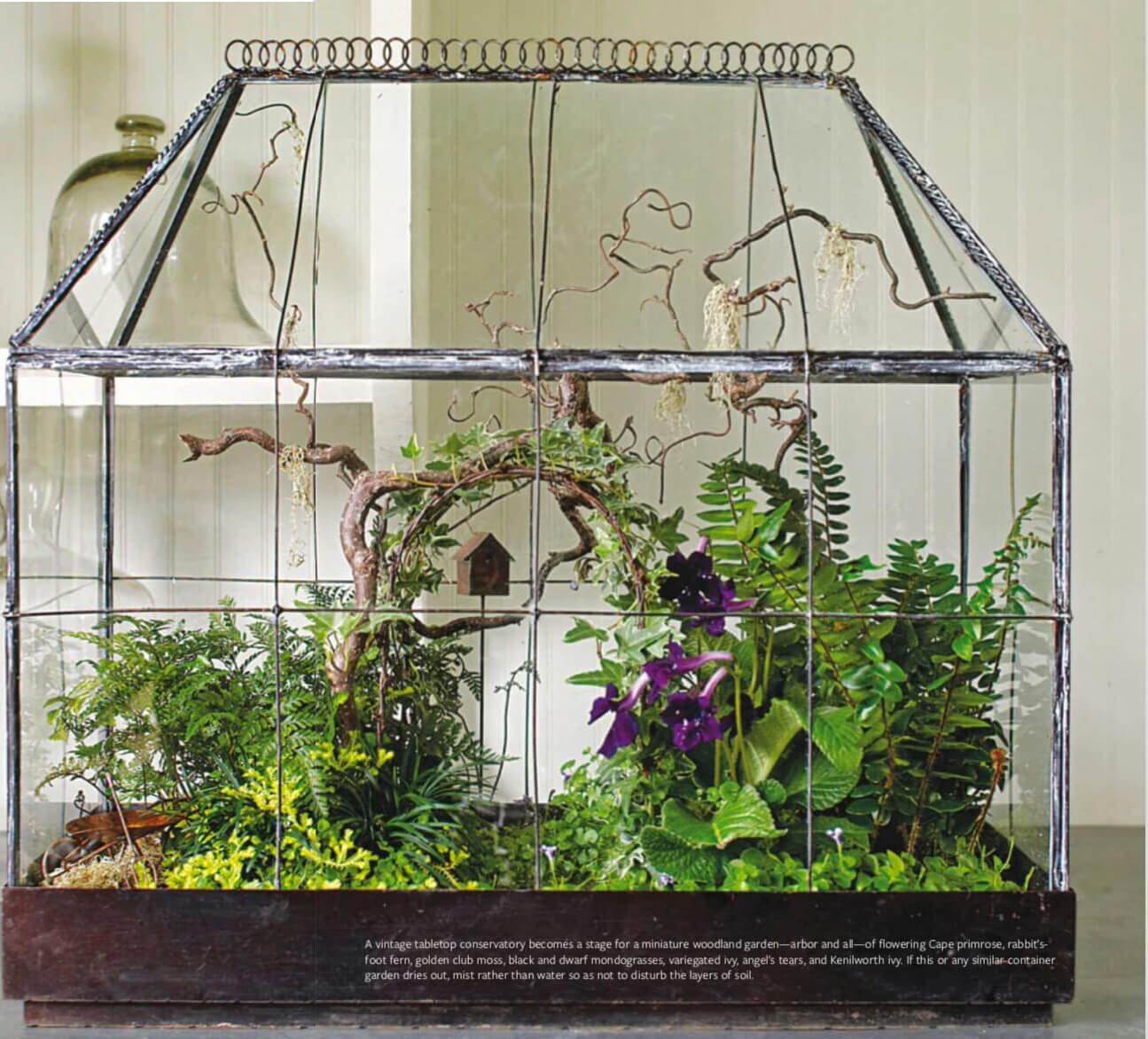
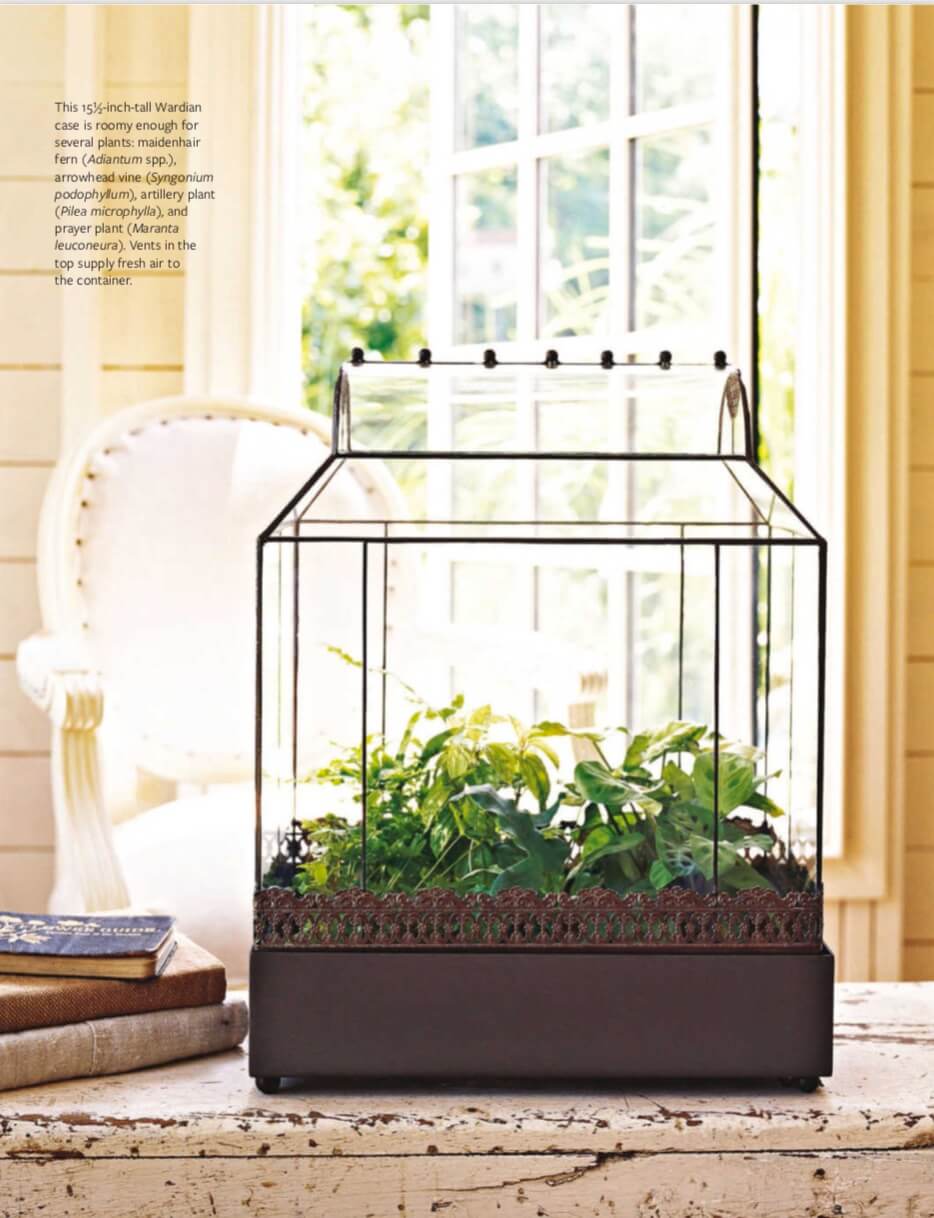
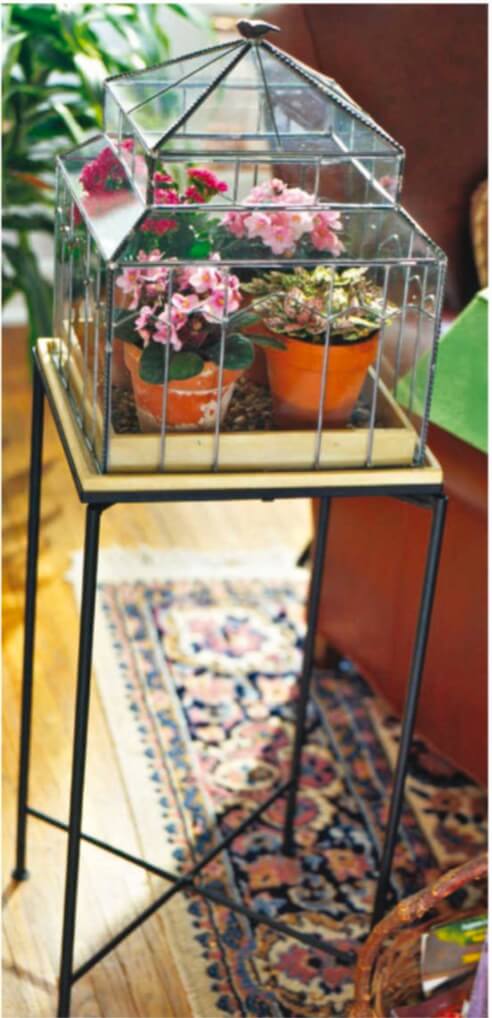
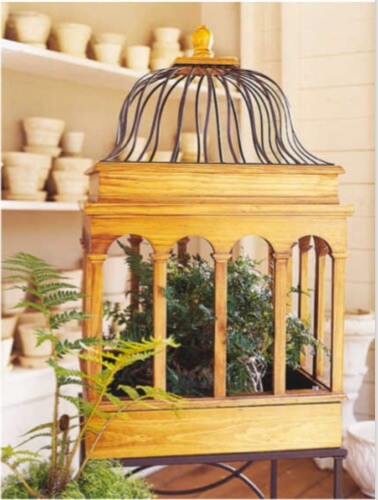
Humidity Loving Plants
These plants like a draft-free, damp environment and do well when given a home in a small conservatory.
- African violet(Saintpaulia spp.)
- Aluminum plant (Pilea cadierei)
- Begonia rex
- Creeping fig (Ficus pumila)
- Earth star(Cryptanthus spp.)
- Fern
- Ivy
- Lucky bamboo (Dracaena sanderiana)
- Moss
- Nerve plant (Fittonia spp.)
- Orchid
- Peperomia
- Pitcher plant (Nepenthes spp.)
- Prayer plant (Maranta leuconeura)
- Strawberry begonia(Saxifraga stolonifera)
- Venus flytrap(Dionaea muscipula)
- Zebra or peacock plant (Calathea spp.)
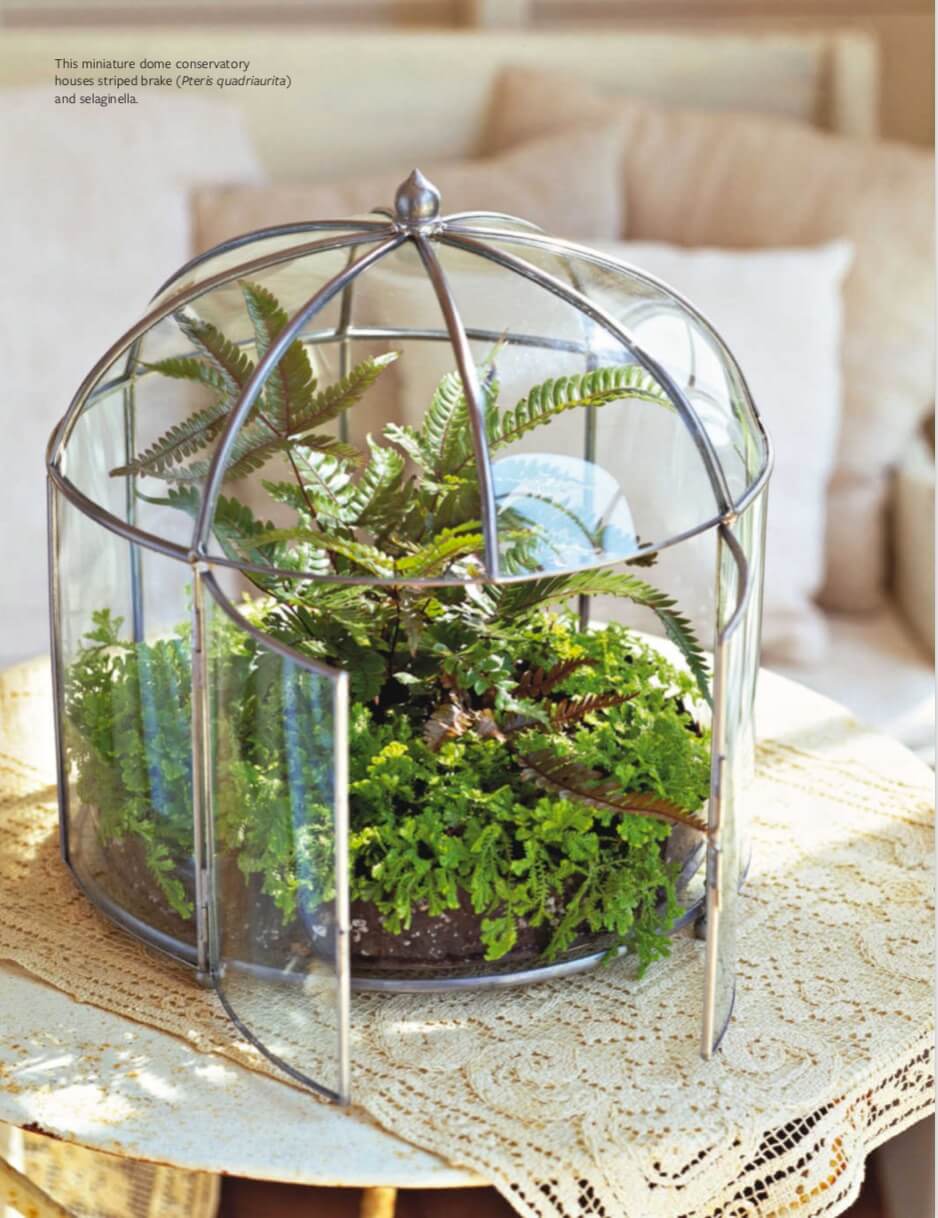
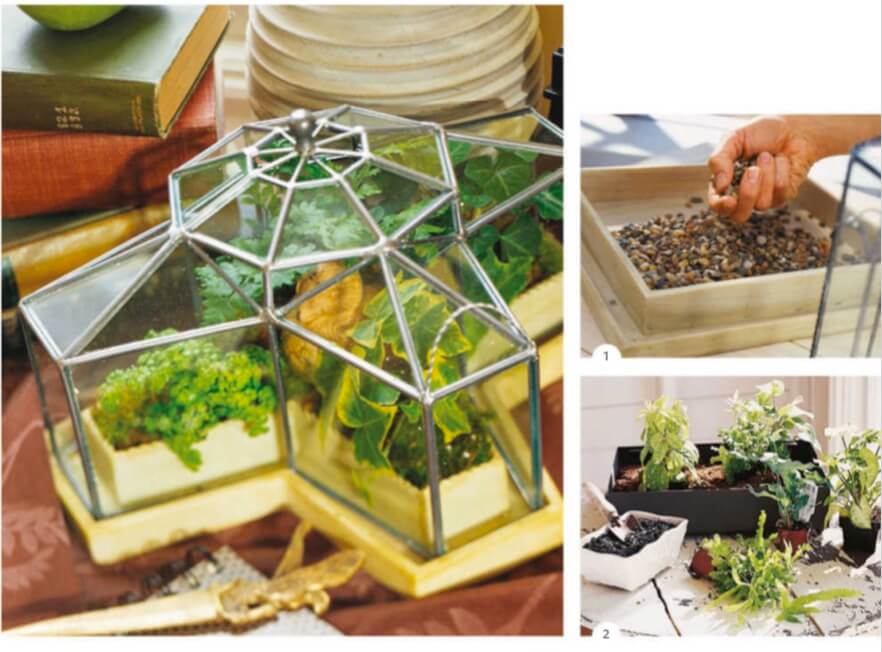
How to Plant a Conservatory
If your conservatory doesn’t have a built-in tray, find one of an appropriate size to set it on. Cover the bottom of the tray with a layer of pea gravel. If the tray is at least 3 inches deep, finish filling it with potting mix for direct planting.
Set a conservatory in bright or diffused light, depending on the plants’ needs, but avoid placing it in direct light to prevent overheating and scorching plants.
Maintain plants in a small conservatory by checking them periodically and watering as needed. Remove the container’s top to ventilate the plants every few days and to prevent fungal or mold problems in the humid conditions.
Step 1
- Plant a Wardian case with a shallow tray by placing a 1-inch layer of pea gravel in the bottom of the tray for drainage. Cover the gravel with a layer of horticultural charcoal chips, available at garden centers. Set potted plants on top of the gravel and charcoal.
Step 2
- Plant a conservatory with a 3-inch-deep or deeper base by covering the bottom of the base with
a 1-inch layer of gravel; sprinkle horticultural charcoal chips over the gravel. Place a piece of cheesecloth on top of the charcoal and gravel. Cover the cheesecloth with a 1-inch layer of potting mix. Set plants’ root balls on the potting mix. Fill in between the root balls with additional potting mix. Gently water the plants.
TIẾNG VIỆT
BÊN TRONG MẶT KÍNH, CÂY NHẬN ĐƯỢC SỰ BẢO VỆ CẦN THIẾT VÀ BẠN NHẬN ĐƯỢC NHỮNG PHÚT GIÂY THƯỞNG THỨC VẺ ĐẸP CỦA CHÚNG.
- ẢNH: HELEN NORMAN, MICHAEL PARTENIO, STEVEN RENDAZZO, ANDGREG SCHEIDEMANN

Hồ cạn (terrarium)
Một hồ cạn chứa đựng nhiều thách thức điển hình của việc làm vườn. Khu vườn thu nhỏ được bọc trong kính hiếm khi mọc cỏ dại. Nhu cầu tưới nước bổ sung được giảm bớt do sự ngưng tụ tạo thành các giọt nước nhỏ giọt trở lại đất và bổ sung độ ẩm. Hộp đựng di động cho phép bạn chuyển hồ cạn từ phòng này hay phòng khác để đón ánh sáng.
Phép thuật dưới lớp kính
Một hồ cạn có thể đầy bất ngờ, chứa một bộ sưu tập các loại cây nhỏ, tương thích với ánh sáng yếu và độ ẩm cao, các cành được phủ bằng địa y hoặc hoa Lan tinh xảo. Trẻ em bị lôi cuốn vào các hồ cạn như một thế giới thu nhỏ, nơi chúng có thể học về cách làm vườn với một vài loại cây trong bể cá cũ hoặc một chiếc bát đựng cá Vàng. Những chậu cảnh dễ chăm sóc nhất giúp bạn có thể dễ dàng thay đổi cách sắp xếp các loại cây bất cứ khi nào bạn muốn.
Hộp đựng mà bạn chọn giúp mang lại sức hấp dẫn cho hồ cạn, từ sự lấp lánh của một quả cầu thủy tinh trong suốt khổng lồ đến vẻ quyến rũ tuyệt vời của một lọ thuốc bào chế có nắp. Một hồ cạn mở ở trên cùng cho phép không khí lưu thông tự do, trong khi một hồ cạn kín chỉ cần được tưới một ít nước và mở cửa thường xuyên để thông gió. Hãy đến các cửa hàng thủ công hoặc chợ bán đồ đựng, cho dù bạn thích một chai rượu mạnh ngoại cỡ hay một lọ dưa muối. Chọn một bình có kích thước vừa với bàn tay của bạn để dễ dàng trồng và chăm sóc. Luôn sử dụng một vật chứa sạch để trồng cây.
Trồng một hồ cạn
Hồ cạn của bạn có thể bao gồm một số cây ăn thịt hoặc những cây trồng trong nhà thấp và phát triển chậm, đây là những loài cây ưa ánh sáng yếu và độ ẩm cao bên trong hồ cạn. Cây có tán lá màu đậm dễ nhìn thấy bên trong kính nhất và tương phản với các cây khác. Bắt đầu với các loại cây có kích thước khác nhau. Các loại cây mọng nước, Xương Rồng và các loại cây ưa điều kiện khô khác sẽ thối rữa nhanh chóng trong hồ cạn kín hoặc ẩm, vì vậy hãy trồng chúng trong một hộp thủy tinh mở và thay vào đó là lớp cát vô trùng với đá cuội.
Tạo hỗn hợp bầu lý tưởng cho hồ cạn bằng cách trộn hai phần ruột bầu làm từ than bùn, một phần cát vô trùng và một phần đá trân châu hoặc đá vermiculite. Sau khi trồng, phủ đất lên trên cùng với rêu, sỏi hoặc cát để tạo hiệu ứng trang trí.
Giữ cho hồ cạn phát triển
Làm ẩm nhẹ đất sau khi trồng, tưới nước nhỏ giọt vào đá cuội. Tưới nước cho hồ cạn khi đất có vẻ khô, cứ 7 đến 10 ngày một lần. Hồ cạn cần tưới nước hai tuần một lần hoặc ít hơn. Lau kính định kỳ từ trong ra ngoài bằng vải sạch.

Làm thế nào để tạo một hồ cạn (Terrarium)

Bước 1
- Đặt khoảng 1 đến 2 inch hạt thủy tinh vào đáy của hộp thủy tinh trong suốt. Sử dụng đá cuội hoặc sỏi hồ cá thay vì hạt thủy tinh nếu bạn thích.
Bước 2
- Thêm một ít vụn than làm vườn. Sau đó, thêm một lớp hỗn hợp bầu từ 2 đến 4 inch, tùy thuộc vào kích thước vật chứa của bạn.
Bước 3
- Nhẹ nhàng đặt từng cây, cắm rễ vào hỗn hợp đất và phủ lên. Làm việc chậm rãi và kiên nhẫn để xác định vị trí của cây.
Bước 4
- Một công cụ có tay cầm dài giúp bạn đưa cây vào trong một cái lọ cổ hẹp để trồng cây vào hỗn hợp đất, che phủ rễ và định vị các thành phần khác, chẳng hạn như đá hoặc lũa.



Nhà kính trên mặt bàn
Các nhà kính thu nhỏ, hồ cạn hay còn được gọi là Wardian, đã được yêu thích bởi những người làm vườn từ thời Victoria. Các vách kính huyền ảo là phiên bản thu nhỏ của các nhà kính và nhà kính trang nhã thường được chụp ảnh trong các khu vườn ở Anh. Các cấu trúc bằng thủy tinh và kim loại hoặc gỗ có kích thước phù hợp vẫn là những điều trong tưởng tượng đối với hầu hết những người làm vườn. Nhưng các nhà kính thu nhỏ cung cấp một giải pháp thay thế hợp lý cho những người có ít tài nguyên hơn. Tất cả những gì cần thiết để tạo nên một trong những khu vườn dưới kính này là một nhà kính và một vài loài cây ưa ẩm, chẳng hạn như Dương Xỉ (fern), Dạ Yến Thảo (dracena) và cây Chấm Bi (polka-dot plant).
Hồ cạn Wardian
Những chiếc vỏ bọc quyến rũ dành cho khu vườn trong nhà này được phát triển vào đầu những năm 1800 bởi một bác sĩ ở London, Nathaniel Ward, người muốn xem một con bướm đêm phát triển trong một chiếc lọ kín. Người đàn ông quá say mê với thành công trong dự án của mình, anh ta bắt đầu trồng các loại cây trong các thùng kính. Chẳng bao lâu sau, những người yêu thích thực vật thời đó, đi lang thang khắp nơi để tìm kiếm những điều mới lạ, họ coi hồ cạn Wardian như một cách để vận chuyển những phát hiện của họ mà không cần tưới nước và mất ít công chăm sóc.
Ngày nay, các hồ cạn Wardian đã bắt đầu trở lại với sự hồi sinh của nghề làm vườn trong nhà và sự phổ biến mới của các hồ cạn. Một hồ cạn đầy phong cách sẽ trở thành một khu vườn trên mặt bàn tuyệt đẹp khi được lấp đầy bởi những củ hoa hoặc cây hàng năm nhỏ, nở theo mùa. Đây cũng là vườn ươm lý tưởng cho các cây non, đặc biệt là Dương Xỉ và các loài khác phát triển mạnh trong môi trường ẩm ướt do cấu trúc tạo ra.
Nhiều nhà kính thu nhỏ có kiến trúc rất quyến rũ, chúng được sử dụng làm bối cảnh đẹp cho một vài cây trồng hoặc các đồ vật trang trí khác. Một số nhà kính nhỏ có khay gắn sẵn. Nếu không, bạn có thể trồng trong khay đủ sâu hoặc đặt các chậu cây trên khay và phủ khay bằng vườn cây.




Cây ưa ẩm
Những cây này thích môi trường không có gió lùa, không ẩm ướt và phát triển tốt khi được trồng trong nhà kính nhỏ.
- Hoa Violet Châu Phi (Saintpaulia spp.)
- Cây Hổ Nhĩ Trắng (Pilea cadierei)
- Cây Thu Hải Đường rex
- Vả leo (Ficus pumila)
- Earth star(Cryptanthus spp.)
- Dương Xỉ (Fern)
- Cây Thường Xuân (ivy)
- Cây Trúc may mắn (Dracaena sanderiana)
- Rêu (Moss)
- Lá may mắn (Fittonia spp.)
- Phong Lan (Orchid)
- Cây Trường Sinh (Peperomia)
- Cây Nắp Ấm (Nepenthes spp.)
- Cây Dong Vằn (Maranta leuconeura)
- Cây Thu Hải Đường Dâu (Saxifraga stolonifera)
- Cây bắt mồi (Dionaea muscipula)
- Cây Đuôi Công (Calathea spp.)

Làm thế nào để trồng một nhà kính thu nhỏ
Nếu nhà kính của bạn không có khay gắn sẵn, hãy tìm một khay có kích thước phù hợp để đặt nó. Phủ một lớp sỏi hạt đậu lên đáy khay. Nếu khay sâu ít nhất 3 inch, hãy lấp đầy khay bằng hỗn hợp bầu để trồng trực tiếp.
Đặt nhà kính ở nơi có ánh sáng chói hoặc ánh sáng khuếch tán, tùy thuộc vào nhu cầu của cây, nhưng tránh đặt dưới ánh sáng trực tiếp để tránh quá nóng và làm cháy cây.
Duy trì cây trong một nhà kính nhỏ bằng cách kiểm tra chúng định kỳ và tưới nước khi cần thiết. Tháo phần trên của thùng chứa để thông gió cho cây vài ngày một lần và để ngăn ngừa các vấn đề về nấm hoặc mốc trong điều kiện ẩm ướt.
Bước 1
- Trồng một thùng Wardian với một khay nông bằng cách đặt một lớp sỏi hạt đậu dày 1 inch dưới đáy khay để thoát nước. Phủ lên sỏi một lớp than vụn làm vườn, có bán tại các trung tâm làm vườn. Đặt các chậu cây lên trên lớp sỏi và than.
Bước 2
- Trồng cây thủy sinh với phần gốc sâu 3 inch hoặc sâu hơn bằng cách phủ một lớp sỏi dày 1 inch lên phía dưới đáy của giá thể; rắc vụn than làm vườn lên sỏi. Đặt một miếng vải thưa lên trên than và sỏi. Phủ một lớp hỗn hợp ruột bầu lên trên tấm vải thưa 1 inch. Đặt bóng rễ của cây vào hỗn hợp bầu. Đổ thêm hỗn hợp bầu vào giữa các bầu rễ. Tưới nước nhẹ nhàng cho cây.

![[Ebook] Indoor Gardening Houseplants 2016 USA Magazine – VII – Gardens Under Glass (Vườn thuỷ tinh) [Ebook] Indoor Gardening Houseplants 2016 USA Magazine – VII – Gardens Under Glass (Vườn thuỷ tinh)](https://vn1.vdrive.vn/codai.net/2021/02/ebook-indoor-gardening-houseplants-2016-usa-vii-gardens-under-glass-01.jpg)


